 |
 |
We started our holiday in Chongqing, where we spent two days of sightseeing. Since Chongqing is built on many hills walking is hard, so we took taxis to travel around. The Liberation Monument is a small tower amidst huge skyscrapers and the 1000-year-old Buddhist Luohan Si temple is not far from there. There were many worshippers and sometimes the smoke was so thick that you could hardly see the temple. Of course also we offered some incense and candles.
After a ride by cable car over the Jialing river and a visit to Chaotianmen Square where the Jialing river meets the Yangtse river, we went to People's Hall, very similar to Beijing's Temple of Heaven. At night a nice hotpot meal should not be missed, certainly not with such a nice view on Chongqing by night and on the Yangtse river.
 |
 |
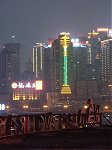 |
Ciqikou is the 1700 years old part of Chongqing with narrow streets, wooden houses and old crafts. If it is raining it is difficult to walk on the cobblestones, but it is worth the trouble. From the centre of Chongqing it is about 1/2 hour by taxi away.
We made the Three Gorges cruise on the Yangtse river from Chongqing to Yichang. Since the start of building the Three Gorges Dam near Yichang the water has already risen to 153 metres and many cities and villages have been relocated to higher grounds. When the dam will be finished, planned in early 2009 or already at the end of this year 2008, the water will rise to 175 metres.
 |
 |
For the first afternoon excursion we had to climb many steps, which is very difficult for Jaap. Fortunately he could hire two porters and a chair to bring him up. And that was quite a job. From above our ship, the Century Star, looks rather tiny.
 |
 |
When we were back at the ship the captain held a Welcome Party. The poor man had to be photographed with all guests, so also with us of course :-) The champagne and the snacks were delicious.
 |
The second day of our cruise the ship sailed through two of the three large gorges. First the short, but very impressive Qutang gorge. After the bridge is the entrance of the second gorge, the Wu gorge. This gorge is much longer and also very nice. Sailing through the gorges is sometimes a bit mysterious.
 |
 |
 |
 |
That afternoon a smaller ferry boat sailed us through the Lesser Three Gorges, which can now be sailed throughout the year, since the water level is so much higher. Little sampans rowed us around the last part of one of these gorges. The rowers even pulled the boats for a while like they used to do on the Yangtse.
 |
 |
 |
After a couple of hours we reached the five-step ship lock at 22.00 hours. It is very impressive. We passed it by night and saw it more clearly the next day from the bus and from the viewing area. Not only the ship lock, but also the Three Gorges Dam is very impressive.
After the cruise we flew from Wuhan to Guilin. A two hour bus trip brings you to Longsheng. Not far from there is Ping'An, a village of the Zhuang and Miao minorities. It is famous for its Dragon's Backbone or Longji rice terraces. Ping'An is built high on the mountain and the path to the village consists of many steps. So, once more we used porters who carried us and our luggage uphill.
 |
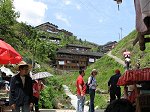 |
 |
From the LiQing hotel we had a splendid view over the terraces and the village with its narrow and winding paths. Don't forget to bring good shoes if you intend to walk here. The paths to the viewing points are steep and slippery after a shower.
 |
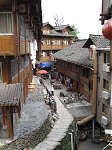 |
The Miao women are well-known for their very long hair and for a little contribution they are willing to unwind it for you. It is amazing how fast and easy they can put it back on their heads. Don't be afraid that you won't find them; they will find you.
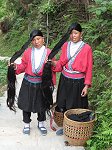 |
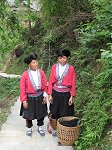 |
The next day it rained all day. We saw the farmers ploughing the rice terraces in the rain. Little dikes were cut through and very slowly the terraces became wet and started to look like the mirror fields you see on postcards. It was a fascinating view.
The Sanjiang area is famous for its waterwheels and wind and rain bridges. Chengyang, a village of the Dong minority, about 30 minutes by bus away from Sanjiang, has a lot of these wheels and probably the nicest Wind and Rain bridge in the area. From the Dong Village Hotel you have a great view on both of them. A round walk over the bridge and through the area is very nice.
 |
We thought that the village of Batuan was not too far away, but it turned out that it was very close to Dudong, about 2-3 hours by bus. The wind and rain bridge was nice, but not worth the trip.
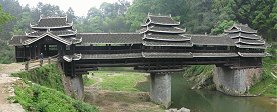 |
We made a short walk through town where most of the houses were made of wood. After a short while we had seen the village and sat down along the street. Thanks to the children waiting for the bus back to Sanjiang was a funny time. Unfortunately the one o'clock bus was very crowded, but we got in. Otherwise we had to wait another three hours and would not be able to come back to Chengyang.
Zhaoxing is another Dong village with a couple of drum towers, which are beautifully set in floodlight at night. We stayed in the Zhaoxing VIP hotel and had a beautiful view over the roof tops, the drum tower and the village. Of course, everything has its price; it was the most expensive hotel we stayed in so far, Yuan 400 per night (approx. euro 40).
 |
 |
 |
The streets and little rivers with wind and rain bridges are very characteristic, just as the people and the children. Traffic you will only find in the main streets. The other streets you can only see on foot.
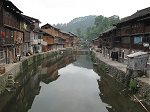 |
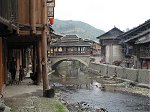 |
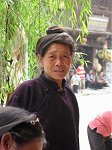 |
 |
After a walk through the backstreets of Zhaoxing we came back to the main street. The drum tower there reflects like a mirror in the water in front of it and it is a nice spot for a picture of the two of us.
 |
 |
During the day several music and dance groups go through town for performances and these people are dressed in very colourful costumes. However, the traditional dress is also used a lot just as horse carts. Zhaoxing is a very nice village that should not be missed if you are in the area in spite of the rough road conditions on some parts of the journey.
Congjiang is not a very interesting place, but it is close to Basha that is located up the hill from Congjiang. Basha is famous for the men who carry swords and have their hair rolled up into topknots. However, since it was raining most people stayed inside and we didn't see these men. The path in the lower part of the village has many steps and is slippery in the rain. You have to be careful if you go down. If you do you might meet these people. Don't forget to arrange a pick-up for coming back to Congjiang. There is not much transportation in Basha.
Back in Congjiang we had a nice meal in one of the little street restaurants. No fridge, no air-conditioning and only a couple of woks, but tasty food and friendly people.
The bus trip from Congjiang to Guiyang, the capital of the province Guizhou, takes about ten hours. The first part goes through the mountains over beautiful, but very winding roads. After about eight hours you finally come to the highway from where it is another 159 km to Guiyang. It was a very long day. The next day, however, was only 1 1/2 hour to Anshun where we stayed in a nice hotel with a fine view over the city. In one of the streets nearby you can have a very special meal of sticks at one of the street vendors.
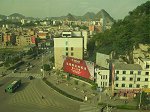 |
 |
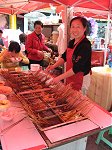 |
Anshun is the city that is closest to the waterfalls of Huangguoshu, the biggest falls in Asia. Buses run every 20 minutes and take about one hour. Please note that some buses stop at a ticket office outside the village from where you have to take a taxi to the parking lot near the entrance of the falls. It is easier to buy your ticket here. After the entrance you walk through a nice garden. Two very long escalators bring you down (and later up again) to the path that leads to the falls. It still is a quite a walk to the falls from here, but the view on the huge waterfalls is worth it.
 |
 |
 |
 |
 |
It is a long distance from Anshun to Kunming. We took a soft sleeper train and arrived after nine hours in Kunming very early in the morning. We had been in Kunming before and had seen most of the places of interest then. So this time we spent a lot of our time in the Green Lake Park, right in the centre of the city. It is a very nice park where a lot of people sing or dance together or just watch other people doing so.
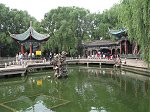 |
 |
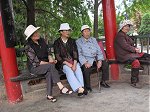 |
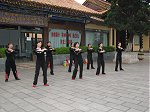 |
Guandu is about 8 km south of Kunming and it is the only place where you can still find some old buildings, old temples and old people still wearing their Mao jackets and hats. A part of the old city has already been renovated and more will be done in the near future. The old wooden houses are now home to modern shops. From the Green Lake to Guandu it takes about half an hour by taxi and Yuan 40 or you can take bus 31 from the Kunming train station for Yuan 1 per person.
Lijiang is a very tourist city, especially the old part of the town. Here you will see Naxi women dancing their cheery dances and lots of western people again who like to wander along the many small canals or have a meal in one of the many restaurants where beautifully dressed ladies will help you choosing your dinner.
The big water wheels near Yulong Bridge are the main gathering point. The market at the other end of town is a place where the Naxi women come together to talk or dance. And everywhere in the old town you will find small canals with nice wooden houses and small bridges.
Unfortunately we had some rain in Lijiang. We spent those hours in the nice restaurant Buon Appetito of Maggie and Rudi. Very friendly people and very tasty dishes, both Italian and Chinese.
Baisha, not to be mixed up with the above mentioned Basha, is another old village, a couple of kilometres outside Lijiang. Once it was the capital of the Naxi kingdom and it has hardly changed since that time (14th century). You can easily bike to the village from Lijiang. There are some halls and temples and outside the museum you can see old houses and Naxi men who like to preserve their own music and play for you for a small donation.
Because of the terrible earthquake in Sichuan province and our scheduled flight out of Chengdu to Amsterdam on 17th May, our last two days in Lijiang were rather thrilling. We didn't know whether we could fly to Chengdu nor whether the plane could leave that city. And indeed our flight from Lijiang was cancelled, also due to bad weather, but fortunately we could take an earlier flight. So if you fly from Lijiang and it is bad, rainy weather, try to be at the airport much earlier. If your China Airlines flight is cancelled, Sichuan Airlines might still fly.
When we arrived in Chengdu late at night the airport was busy but undamaged and the city itself seemed to be unharmed. We had been in Chengdu twice before, but decided to visit again some of the temples in town, like the Green Ram Temple and the Wenshu Temple. The weather was nice and warm, though you don't see that on the pictures due to a little smog.
 |
 |
We had a lovely hotpot meal not far away from the Wenshu Temple and suddenly we got a little after shock. Everyone was a bit upset of course, just like we and therefore we decided to stay outside buildings for the remainder of the day. The People's Park was a fine place to go, where we had some tea and looked at the tiny boats on the stream and the lake.
We had a marvellous holiday once again, but this time we were very glad to go away from the dangerous area in Sichuan. We wish all people there lots of luck and happiness in the future again and we hope that the disaster will as soon as possible be over again.
last revision: 12 June 2008
Marion & Jaap
Fahrenfort-Nietfeld
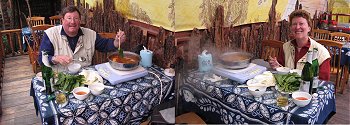 |